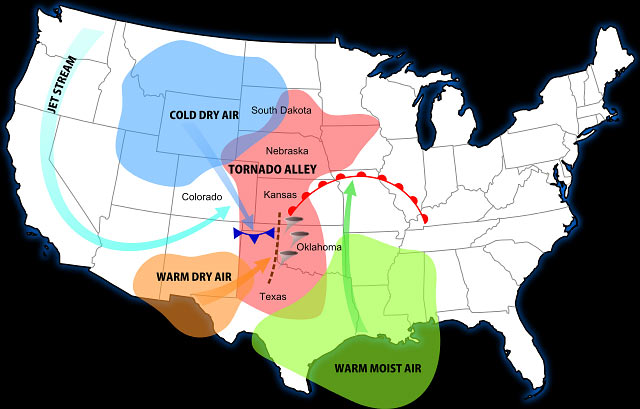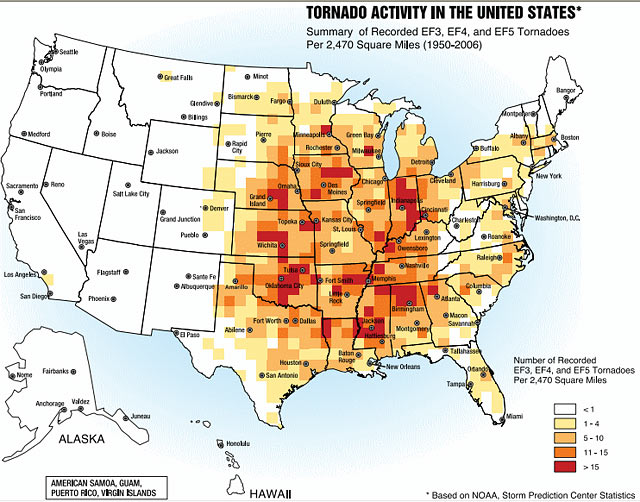Tornado Alley, Tornado Facts, And How They Form
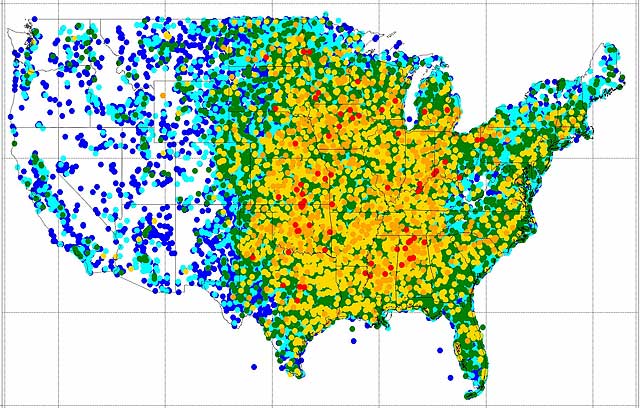
Tornadoes occur mostly in the United States. On average, 1,200 tornadoes cause 1,500 injuries and 65 fatalities per year in the U.S. (source: spc.noaa.gov)
Here’s more about “tornado alley”, tornado facts, and how they form:
Also, a question for you…
For those who live with the threat of tornadoes, do any of you have a specific storm shelter integrated with your home or property? If not, what are your preparedness plans if a tornado is approaching?
Where is Tornado Alley?
Tornado Alley is an area of the United States where tornadoes are most frequent.
Although the official boundaries of Tornado Alley are not clearly defined, its core extends from northern Texas, Oklahoma, Kansas, into Nebraska.
Note: Tornadoes don’t form just in tornado alley!
Important!
Midland WR120-EZ NOAA Weather and All Hazard Public Alert Radio
Where do Tornadoes form in the United States?
The following map of tornado activity in the United States is a summary of recorded EF3, EF4, and EF5 tornadoes between 1950 – 2006.
Related: Tornado Season
Historical Record of Tornado Tracks (1950-2011)
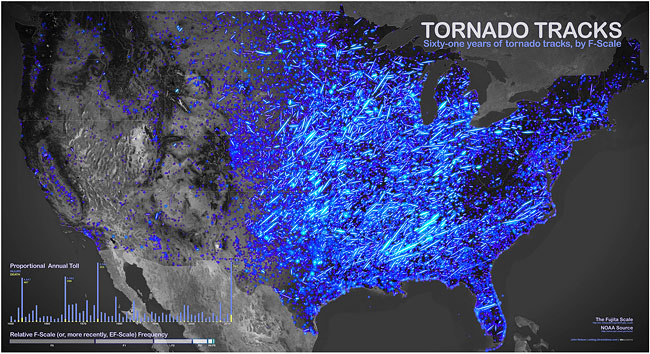
Image: uxblog.idvsolutions.com
Full size image (1920×1046)
Tornado Facts
source: NOAA National Weather Service
A tornado is a violently rotating column of air extending from a cumuliform cloud, such as a thunderstorm, to the ground.
Tornadoes may appear nearly transparent until dust and debris are picked up or a cloud forms within the funnel.
The average tornado moves from southwest to northeast, but tornadoes can move in any direction and can suddenly changer their direction of motion.
The average forward speed of a tornado is 30 mph but may vary from nearly stationary to 70 mph.
The strongest tornadoes have rotating winds of more than 200 mph.
Tornadoes can accompany tropical storms and hurricanes as they move onto land.
Waterspouts are tornadoes that form over warm water. Water spouts can move onshore and cause damage to coastal areas.
Tornadoes can occur at any time of day, and any day of the year.
88% of all tornadoes are weak, producing EF0 or EF1 damage and last 1-10 minutes.
11% of all tornadoes are strong, producing EF2 or EF3 damage, cause nearly 30% of all tornado deaths, and last 20 minutes or longer.
1% of all tornadoes are violent, producing EF4 or EF5 damage, cause 70% of all tornado deaths, and can last longer than 1 hour.
The Enhanced Fujita Scale
EF0 (65-85 mph)
EF1 (86-110 mph)
EF2 (111-135 mph)
EF3 (136-165 mph)
EF4 (166-200 mph)
EF5 (Over 200 mph)
How Tornadoes Form
source: “Thunderstorms, Tornadoes, Lightning…” Preparedness Guide (NOAA)
Step 1. Before thunderstorms develop, winds change direction and increase in speed with altitude. This creates an invisible, horizontal spinning effect in the lower atmosphere.
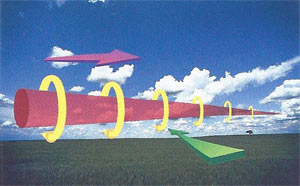
Step 2. Rising air within the thunderstorm updraft tilts the rotating air from horizontal to vertical.
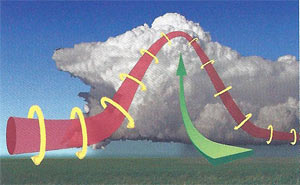
Step 3. An area of rotation, 2-6 miles wide, now extends through much of the storm. Most tornadoes form within this area of strong rotation.
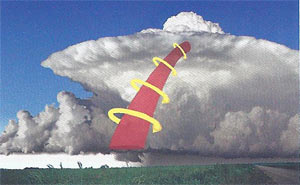
Related: 10 Tornado Signs
I do not live in a region where tornadoes form very often. For those of you who do, I am curious to hear about your own experiences. Also, do any of you have a specific storm shelter integrated with your home or property? If not, what are your preparedness plans if a tornado is approaching?
I hope that you all at least have one of these:
Midland WR120-EZ NOAA Weather and All Hazard Public Alert Radio

